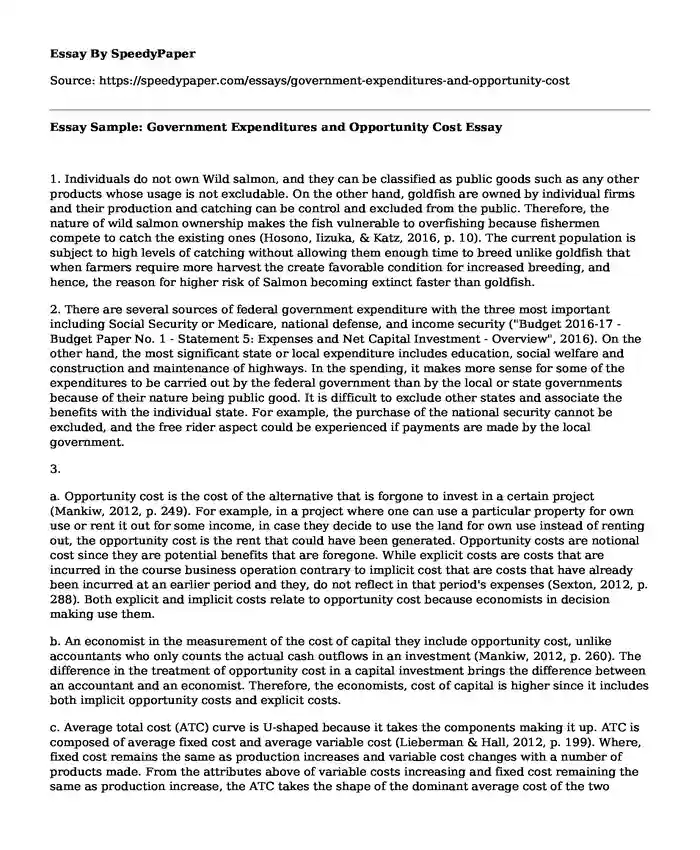
| Type of paper: | Essay |
| Categories: | Economics Government |
| Pages: | 3 |
| Wordcount: | 799 words |
1. Individuals do not own Wild salmon, and they can be classified as public goods such as any other products whose usage is not excludable. On the other hand, goldfish are owned by individual firms and their production and catching can be control and excluded from the public. Therefore, the nature of wild salmon ownership makes the fish vulnerable to overfishing because fishermen compete to catch the existing ones (Hosono, Iizuka, & Katz, 2016, p. 10). The current population is subject to high levels of catching without allowing them enough time to breed unlike goldfish that when farmers require more harvest the create favorable condition for increased breeding, and hence, the reason for higher risk of Salmon becoming extinct faster than goldfish.
2. There are several sources of federal government expenditure with the three most important including Social Security or Medicare, national defense, and income security ("Budget 2016-17 - Budget Paper No. 1 - Statement 5: Expenses and Net Capital Investment - Overview", 2016). On the other hand, the most significant state or local expenditure includes education, social welfare and construction and maintenance of highways. In the spending, it makes more sense for some of the expenditures to be carried out by the federal government than by the local or state governments because of their nature being public good. It is difficult to exclude other states and associate the benefits with the individual state. For example, the purchase of the national security cannot be excluded, and the free rider aspect could be experienced if payments are made by the local government.
3.
a. Opportunity cost is the cost of the alternative that is forgone to invest in a certain project (Mankiw, 2012, p. 249). For example, in a project where one can use a particular property for own use or rent it out for some income, in case they decide to use the land for own use instead of renting out, the opportunity cost is the rent that could have been generated. Opportunity costs are notional cost since they are potential benefits that are foregone. While explicit costs are costs that are incurred in the course business operation contrary to implicit cost that are costs that have already been incurred at an earlier period and they, do not reflect in that period's expenses (Sexton, 2012, p. 288). Both explicit and implicit costs relate to opportunity cost because economists in decision making use them.
b. An economist in the measurement of the cost of capital they include opportunity cost, unlike accountants who only counts the actual cash outflows in an investment (Mankiw, 2012, p. 260). The difference in the treatment of opportunity cost in a capital investment brings the difference between an accountant and an economist. Therefore, the economists, cost of capital is higher since it includes both implicit opportunity costs and explicit costs.
c. Average total cost (ATC) curve is U-shaped because it takes the components making it up. ATC is composed of average fixed cost and average variable cost (Lieberman & Hall, 2012, p. 199). Where, fixed cost remains the same as production increases and variable cost changes with a number of products made. From the attributes above of variable costs increasing and fixed cost remaining the same as production increase, the ATC takes the shape of the dominant average cost of the two components. Therefore, as production increases the average fixed cost reduces and offers an opposing force to the average variable costs leading to the formation of a U-shaped curve as they are combined to form ATC (McTaggart, Findlay, & Parkin, 2015, p. 291).
4. Actual or potential restrictions on advertisement of liquor and cigarettes do not reduce the sale of the products because of the addiction factor in them. The consumer of the products continues using them even without advertisements (O'Guinn, Allen, & Semenik, 2014, p. 102). The affected group in the move to restrict the advertisements is on the new entrants and actual completion in the business, but the consolidated revenues from the products do not change because consumers continue using them even without advertisements and promotions. The government tax revenue does not reduce because of the restrictions hence tax maximization is not affected negatively.
References
Budget 2016-17 - Budget Paper No. 1 - Statement 5: Expenses and Net Capital Investment - Overview. (2016). Budget.gov.au. Retrieved 30 June 2016, from http://www.budget.gov.au/2016-17/content/bp1/html/bp1_bs5-01.htm
Hosono, A., Iizuka, M., & Katz, J. (2016). Chile's Salmon Industry. Springer.
Lieberman, M. & Hall, R. (2012). Principles and applications of economics. Mason, Ohio: South-Western Cengage Learning.
Mankiw, N. (2012). Principles of economics. Mason, OH: South-Western Cengage Learning.
Mankiw, N. & Taylor, M. (2006). Economics. London: Thomson.
McTaggart, D., Findlay, C., & Parkin, M. (2015). Economics (7th ed.). Sydney: Addison-Wesley.
O'Guinn, T., Allen, C., & Semenik, R. (2014). Advertising and integrated brand promotion (2nd ed.). Mason, Ohio: Thomson/South-Western.
Sexton, R. (2012). Exploring economics. [Mason, Ohio]: South-Western/Thomson Learning.
Cite this page
Essay Sample: Government Expenditures and Opportunity Cost. (2019, Oct 08). Retrieved from https://speedypaper.com/essays/government-expenditures-and-opportunity-cost
Request Removal
If you are the original author of this essay and no longer wish to have it published on the SpeedyPaper website, please click below to request its removal:
- Free Essay on Katherine Dunham's Infusion of Caribbean Dance Style in Her Work
- Free Essay on Human Resource Management in a Company
- Free Essay Example: Reasons for Gun Violence
- Free Essay Sample: Gender Inequality in the Irish Society
- Free Essay Sample: Microsoft as a Marketing Success
- Education Essay Example: Succeeding in College
- The effects of strategic and manufacturing flexibilities and supply chain agility on firm performance in the fashion industry
Popular categories




